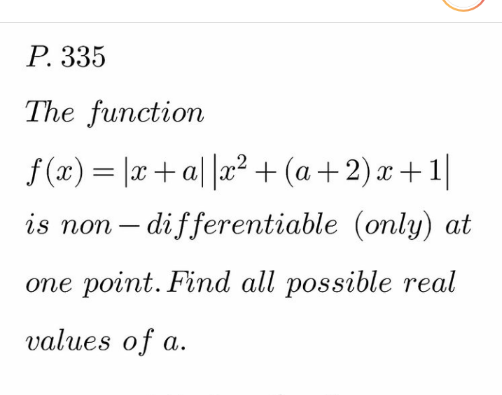
Question and Answers Forum
Question Number 165164 by mnjuly1970 last updated on 26/Jan/22

Answered by aleks041103 last updated on 27/Jan/22
![f(x)=∣(x+a)(x^2 +(a+2)x+1)∣ for this to be non−diff at only one point we need (x+a)(x^2 +(a+2)x+1) to change signs only once. Since one always exists at x=−a, we need x^2 +(a+2)x+1 to not have real roots or to have exactly one with algebraic multiplicity of 2 or one of the roots of x^2 +(a+2)x+1 to coincide with the root of x+a, i.e x=−a. ⇒D=(a+2)^2 −4≤0 ⇒a(a+4)≤0 a∈[−4,0] or (−a)^2 +(a+2)(−a)+1=0 a^2 −a^2 +1−2a=0 ⇒a=0.5 then the other roots of f(x) are −0.5,−2,−0.5, which makes for one change in sign. ⇒Ans. a∈[−4,0]∪{(1/2)}](Q165179.png)
| ||
Question and Answers Forum | ||
Question Number 165164 by mnjuly1970 last updated on 26/Jan/22 | ||
 | ||
Answered by aleks041103 last updated on 27/Jan/22 | ||
![f(x)=∣(x+a)(x^2 +(a+2)x+1)∣ for this to be non−diff at only one point we need (x+a)(x^2 +(a+2)x+1) to change signs only once. Since one always exists at x=−a, we need x^2 +(a+2)x+1 to not have real roots or to have exactly one with algebraic multiplicity of 2 or one of the roots of x^2 +(a+2)x+1 to coincide with the root of x+a, i.e x=−a. ⇒D=(a+2)^2 −4≤0 ⇒a(a+4)≤0 a∈[−4,0] or (−a)^2 +(a+2)(−a)+1=0 a^2 −a^2 +1−2a=0 ⇒a=0.5 then the other roots of f(x) are −0.5,−2,−0.5, which makes for one change in sign. ⇒Ans. a∈[−4,0]∪{(1/2)}](Q165179.png) | ||
| ||